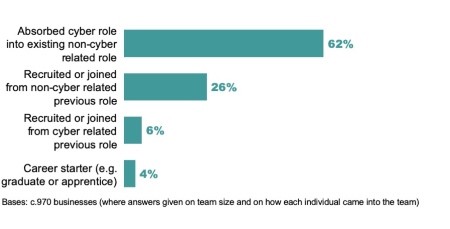5 Ways to Boost Talent Retention in 2023
3 min read.As many employers double down on their retention efforts amid economic instability, here are our top recommendations to keep your best people.
1. Internal mobility
The best talent often comes from within. Not only are internal hires significantly more efficient, taking around half the time of a regular applicant, they also tend to be a more reliable and quality hire.
While we’re used to thinking of career progression as a ladder, a vertical journey from one rung to the next, progressive companies are starting to think about more agile development pathways for employees. Pathways which allow employees to redirect to new roles and departments they might not have considered an option before. For example, an employee may start in marketing and end up in HR or move from research into sales.
When we think about cybersecurity specialists, the vast majority didn’t start their career in that sector because it's a very niche skill set. Most came from different areas of the business, other technology roles, data roles, or even wider because it's more about the transferable skills and mindset they bring with them than having a specialist skillset.
(Source: Gov.co.uk) Career pathways into cyber roles outside the cyber sector:
These ‘squiggly’ careers are a great way to mine talent from within, heighten employee morale and reward hard workers. If an employee has the right mindset, you can teach them the skillset.
Since ‘Lack of career progress’ is considered the top red zone for turnover, with 27% of workers agreeing that it would turn their heads to new employment opportunities, leaders can make a real impact by keeping an open mind, upskilling and retraining workers and expanding their internal marketplace.
Remember that workers who are actively job-seeking are often just looking for new opportunities and experiences. While Gen Z are the most satisfied with their roles as a generation (92%), they are interestingly also the most likely to leave (55%). If you could offer these younger workers the change of pace they crave with a new desk, rather than a new company, why wouldn’t you?
2. Wellbeing
Wellbeing is currently high on the agenda as a talent retention approach. The pandemic exacerbated time-honoured corporate challenges to employees’ emotional health and this shows no sign of dissipating. Gallup revealed that 3 in 4 employees experience workplace burnout at least sometimes.
Where wellbeing initiatives were once a nice-to-have, people have been through the mill, and expect their wellbeing to be looked after more now than in the past. In fact, research from Mercer shows that thriving employees are seven times more likely to work for a company that prioritizes employee well-being.
When it comes to implementing wellbeing initiatives, you can never safely assume you know what workers want. Always base decisions on feedback rather than initiative. Given that the top causes for burnout are unfair treatment, unmanageable workloads and unclear communication from managers, do your due diligence when considering the impact of these factors on your workforce before investing in that state-of-the-art gym.
3. Talking about stability
We know that altruistic aspects of a role, like a sense of belonging and purpose-driven work, are still important to people but ultimately, they’ve got bills to pay. When we go into recessions and people develop greater financial concerns, they tend to go back to those core questions, “Is my job secure? Is the business secure?”
Research from Gallup shows that over half of workers (53%) crave jobs that provide greater stability than the one they currently have.
A lot of employers don't do it but sharing that the business is thriving is a simple thing you can do to reassure employees that their jobs are secure.
Communicate where you’re currently at, what your future business plans are, and share your vision to further build the stability of the business.
4. Referral scheme
If you’ve got great talent, chances are they know great talent. Having a referral programme that links back to your company purpose is another great way to source from within and encourage employees to hold greater stakes in the company’s success.
Like internal hires, referrals tend to be better-quality recruits, providing a conversion rate up to 10 times higher than regular applicants. They already have an established link to the organisation and may find it easier to acclimatise as a result.
By staggering your financial incentives (an initial payment when the referral joins and a bonus when they successfully complete their orientation period), you encourage people to only recommend contacts who they think are suitable and likely to stay in their role, which will boost retention.
5. Personalised benefits
Personalised benefits are a massively growing area that will help you to retain the right people. Personalisation could come in the form of tailoring to your brand values, or employees’ lifestyle and generation.
According to research from REBA, nine in 10 will be making changes over the next two years. By 2024, 85% of employers will focus on personalisation, which is a drastic uptick from the current 25%.
When designing your benefits, lean into specific problems and pain points for your employees and try to solve them. When a bank that we’ve been working with for some years realised that people weren’t taking jobs at their call centre because it was too difficult to get to, they started offering a free bus service as an incentive, which was received well.
If there’s something unique and particular about your brand purpose, and you can align your benefits back to that, all the better. Nike’s aim, for example, is to bring sport into every day, so offering free on-site gyms as a benefit to their employees makes perfect sense. They live their purpose and compound on the reason they were initially attractive to employees.


